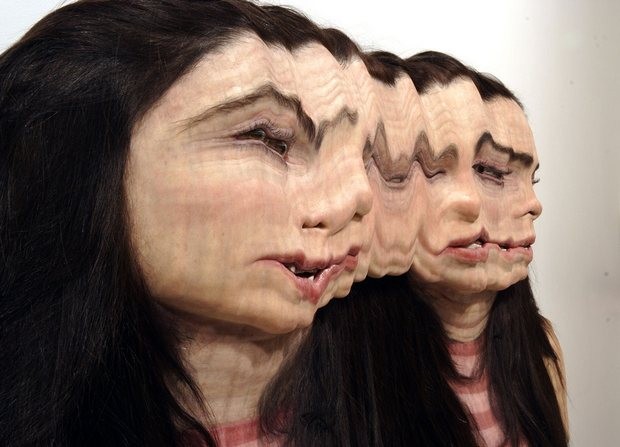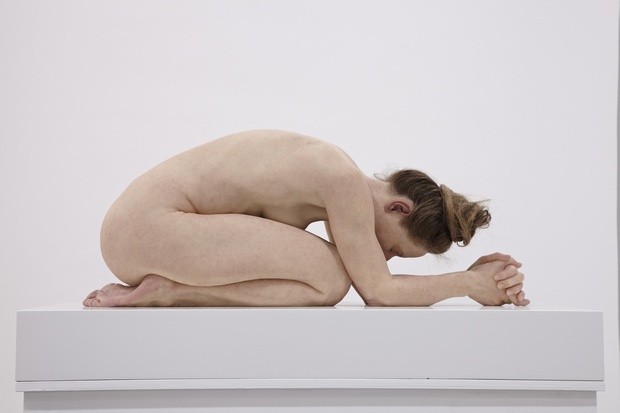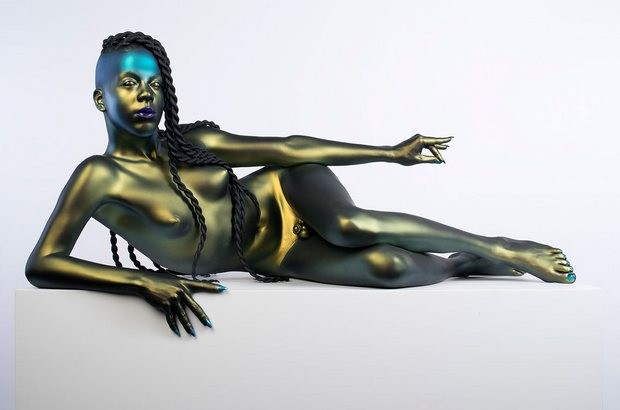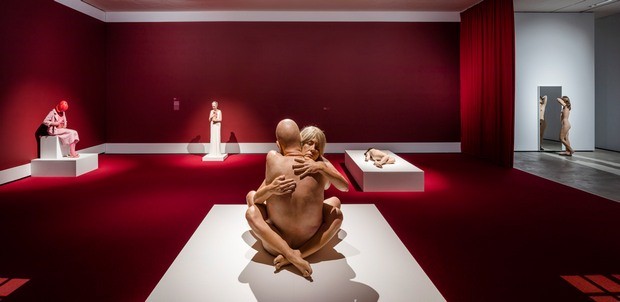Gosh! Is It Alive?
04 Feb - 06 Aug 2017

The human body takes over ARKEN with warts and all.
4 February - 6 August 2017
Sweat, freckles, wrinkles, pores and veins. In a ‘lively’ exhibition, 39 human body sculptures by 31 internationally acclaimed artists have taken up residence at ARKEN. The artworks make use of extreme realism, which imitates the surrounding world with an overwhelming wealth of detail. The bodies are almost more real than reality itself – they are hyperrealistic. Encountering the works, we come exceptionally close to other ‘human beings’, and the experience is both titillating and transgressive.
These sculptures allow us to dwell on the human body in many different forms and stages of life. Our curiosity is seriously put to the test. The works are either harrowingly honest, grotesquely distorted or imaginatively liberating in their depiction of reality. With technical perfection, psychological understanding, disturbances of scale, humour and existential reflection, the hyperrealist sculptures raise highly relevant questions about what it means to be human at this point in time when robot technology, cloning and artificial intelligence have turned science fiction into reality. Are the bodies before us alive? The seed of doubt is sown.
The dream of human replication
The exaggerated realism that we find in hyperrealistic sculpture is intertwined with humankind’s dream of self-recreation. Humanoid robots, doppelgängers or distorted creatures play important roles in a long succession of horror and science fiction films from the classic about Frankenstein’s monster to Blade Runner, Alien, Terminator and Ex Machina. Most recently the series Westworld has aroused enthusiasm.
Today, research has taken us closer than ever to the realization of our dreams or nightmares about humanoid robots and machines. Most recently, CRISPR, a new genetic technology, has made it possible to edit our genetic material and design ‘super babies’. Some day we may also see cloning of humans. The exhibition is closely related to this reality. Many of the lifelike sculptures resemble human replica from a near future. We are reminded of the necessary ethical and existential decision-making processes introduced by the numerous possibilities and corresponding dilemmas of the new technology.
The human hybrid
All the artists represented in the exhibition are concerned with the human body and sculpture. Some imitate the body on a scale of 1:1, while others work with fragments or distortions in size and proportion. Some artworks are crudely processed with unnatural surfaces and a coarse expression. These sculptures do not strive to represent the body as it looks, but as it feels. Here the skin is not necessarily hyperrealistic, and the works speak more of a state of mind or a physical sensation.
A number of the exhibition’s artworks thematise the effect of technology on the human body, which today can be retouched and optimized – both physically and digitally. So the idea of the cyborg – half human, half machine – is no longer reserved for science fiction.
The fusion between organic forms and technology is evident in Frank Benson’s digitally created sculpture portraying Juliana Huxtable – a young fashion model, artist and transgender it girl from New York. Juliana occupies the podium as a liberated sci-fi beauty renouncing all conventional ideas of gender and the ideal body. The work celebrates Juliana’s courage and the cyborg’s liberating potential. Several of the artists demonstrate how our identity is neither static nor a foregone conclusion. They highlight daily self-presentation as an integral part of being a person. In Erwin Wurm’s performative work, you can even occupy the podium yourself and pose as a work of sculpture. The scene is yours. Here the fantasy of the living sculpture becomes reality. Is it alive? Yes!
The pursuit of illusion
The ancient Greek artist Zeuxis is reported to have had the ability to paint grapes so realistically that real birds tried to peck at them. True-to-life imitation has been one of the most important endeavours of artists from the Renaissance to the emergence of photography. Hyperrealism began to flourish in the 1960s as a backlash to the abstract art of the 20th century. However, the trend was not a return to naturalism and the cultivation of the believable illusion. Hyperrealism was inspired by pop and conceptual art and prioritised the artwork’s context and idea, as well as its lifelike appearance.
The point of departure for the first wave of hyperrealism was social-realistic, and the artists intended to portray ordinary life by using casts of living people. Production processes and materials of that time, such as fiberglass, polyester resin and synthetic wigs, did not allow for the chilling lifelikeness that silicon and human hair offer today. The artists supplement the new materials with modern digital techniques like 3D scanning and printing. Hyperrealism bears a resemblance, and the genre goes hand in hand with perfection and virtuoso craftsmanship.
Participating artists:
Zharko Basheski (MK), Frank Benson (US), Berlinde de Bruyckere (BE), Maurizio Cattelan (IT), Brian Booth Craig (US), John Davies (UK), John DeAndrea (US), Keith Edmier (US), Carole A. Feuerman (US), Daniel Firman (FR), Robert Gober (US), Robert Graham (US), Duane Hanson (US), Uffe Isolotto (DK), Sam Jinks (AU), Allen Jones (UK), Peter Land (DK), Tony Matelli (US), Paul McCarthy (US), Ron Mueck (AU), Juan Muñoz (ES), Evan Penny (ZA), Patricia Piccinini (AU), Mel Ramos (US), Jamie Salmon (UK), George Segal (US), Marc Sijan (RS), Kurt Trampedach (DK), Anna Uddenberg (SE), Xavier Veilhan (FR) and Erwin Wurm (AT).
Lighting design by the art and design studio YOKE.




